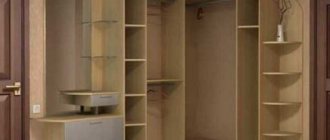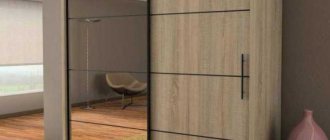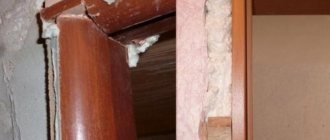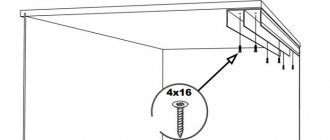To hang curtains on the cornice, a special tape is used; it is fixed with machine stitching on the top edge of the material. Thanks to this, it becomes possible to give an interesting shape to curtains and drapes - to create folds. To do this, you first need to learn how to sew a ribbon to tulle; this type of ribbon is available in hardware and fabric stores.
What is curtain tape
Another name is Australian ribbon. It is used to solve various problems, including:
- fixing the canvas on the cornice;
- strengthening the edges of the material of curtains, drapes, curtains;
- reduction of time for finishing the product: the tape is designed in such a way that there is no need to additionally sew on other elements;
- improving the decorative qualities of the curtain.
Tape for hemming curtains (grommet) is a strip in the form of textile braid. However, its structure is more complicated: there are many slots, which allows you to quickly make loops for attaching to the hooks of the cornice.
It is enough just to lift the strip of material in the center of the ribbon. In addition, cords run through the entire textile braid. This is the name for strong cords (2 pieces or more), which are designed to give shape to drapes and curtains.
If you pull the cords on the sides, waves and folds form first along the edges and then in the center. You can model their different shapes. In this case, the folds will differ in width. There is an opportunity to collect material. As a result, small folds are formed. Use your hands to distribute the material along the cords. If necessary, large waves are formed. In this case, the size of the folds and the general appearance of the product depend on the material from which the curtains are made. Large waves form on thick curtains. If you tighten the cords too much, small wrinkles will appear.
Sew textile braid on the wrong side of the material. In this case, 2 lines are made: at the top and bottom of the tape, and sometimes more. It is important to pre-treat the edge along which the strip will be sewn. This step is skipped when the tape is located on the side on which the edge is provided (factory processing). If this is not done, the material will unravel, because the grommet tape does not cover the edge and does not protect it from damage. On the front side of the curtain you will see the stitching that secures the braid.
How to hem tulle - tips for beginners
If you have a sewing machine at home, then you can handle hemming tulle easily, quickly and easily. First, you should take the necessary measurements and, if possible, cut off the excess length.
If you don't want to cut the fabric, make a few hems and baste by hand or using a machine.
Make long stitches and use pins or needles as needed. After basting, iron the hem thoroughly, this will help make the fold line as straight as possible. Next you should sew it on a sewing machine.
The length of the seams should be minimal.
At the beginning and end of each line, do not secure the thread. After everything is stitched, simply tie the ends of the threads tightly. All that remains is to connect the curtain tape (braid) with the tulle.
How to do this correctly will be discussed in the next section.
Types of curtain tapes
There are 2 types of products (they differ in structure and material properties):
- transparent;
- dense.
The first option is used for attaching to transparent fabrics (this group includes tulle, organza, mesh, veil, etc.). Thick eyelet tape is suitable for curtain materials; it will not look organic on a light curtain with high light transmittance. There are types of braid that differ in shade: plain, colored. For transparent curtains, the first option is suitable. Colored curtains are fixed to the cornice using braid that matches the color scheme of the product in shade.
There are different types of ribbons that differ in drapery. But the classic version is more common - a narrow braid without decoration. This type of product can be fixed on any type of curtains, including hailstones and sheer curtains. The braid is distinguished by the method of fastening:
- with loops (Velcro) - used for fixing on a cornice in the form of a pipe, which is literally put on such a tape;
- with threads (cords) and slots - hanging version, designed for fastening on hooks.
The choice of product type should be made taking into account the characteristics of the curtain. The braid also differs in width.
Forming folds in tulle using sewn curtain tape
After sewing the curtain tape to the tulle, the main thing is not to forget about another important function - the ability to form draperies and folds. But before that, tightly tie the laces that hold the material together at the ends of the tulle. The tulle can be washed in the assembled state, when the laces are tightly tied.
This will make it more convenient to wash, but ironing should, on the contrary, be in a straightened state.
If the fittings are sewn correctly and neatly, then beautiful folds will form throughout the material. But what to do with the laces that will hang down at the edges? Experienced craftswomen advise making a secret pocket on the wrong side of a piece of tulle.
You can make a pocket in which the laces will hide.
On the sewing tape itself there are holes into which hooks are inserted for attaching to the cornice. String the hooks at a distance of approximately 8 - 12 centimeters from each other. After the tulle is sewn in, the curtain tape is sewn and the hooks are strung, you can hang the curtain on the curtain rod. Ready!
For transparent, airy fabric, it is best to use thin polyester curtain tape.
Selection criteria and length calculation
Parameters to pay attention to:
- braid material: for transparent or thick fabrics;
- number of rows with loops (1 or more): in this case, you need to take into account the length of the curtain; if you need to hem the product, attach it to the bottom row of loops, otherwise, to increase the length (fix it along the top row);
- the width of the tape is from 2 to 10 cm, the wider variety is used for heavy curtains, the narrow one is used for light, transparent curtains; the width of the edge on which the tape will be fixed is also taken into account;
- when choosing, you need to take into account the assembly coefficient - one of the characteristics of the braid; in order to calculate it, you need to know the width of the curtains in their initial form and after assembling the material, the range of values is quite wide, in most cases they take the indicator 1.5 as a basis, for complex drapery - 3.
Additionally, you can study the markings of the braid. This will allow you to determine the intended purpose of the product. For example, if among the characteristics there is the letter “Z”, you need to use a tape for fixing on thick curtains; for light ones, choose the option with the designation “F”, for transparent ones - “/Z”. The universal option is “U”.
How to choose and sew curtain tape: master class + video
What is curtain tape and why is it needed?
Photo: derbybraid.co.uk
Curtain tape is a special braid that greatly facilitates the process of sewing curtains and creating a beautiful, uniform drapery on them. Several cords are stretched along the entire length of the tape - they allow you to add folds to the curtains and make drapery. The tape also has a special strip in which holes are made for threading hooks to hang the finished curtain. The tape is sewn to the finished curtain from the inside out at the top.
Fashionable curtains 2018: main trends and photos
What types of curtain tapes are there? How to choose the right one?
Curtain tapes differ in several ways.
1. Width
The width of the tapes is from 1.5 to 10 cm.
A narrow tape is used for light curtains, a wide one for heavy ones, for example, curtains.
Photo: starcurtaintape.com
2. Transparency
Curtain tape can be translucent or thick, white.
Transparent braid is used for curtains made of light translucent fabrics. White - for everyone else.
Photo: integralbook.com
Photo: williamgee.co.uk
3. Possibility of forming folds
The cords in the curtain tape can be pulled evenly or in a certain “pattern”.
Depending on this, the tape makes it possible to make simple folds and waves or curly folds on the curtain.
Photo: cheerycurtains.com
4. Mounting method
Curtain tapes can be sewn or glued.
The second option is attached to the fabric using an iron and is only suitable for light and short curtains, since the fastening is not very strong. The first option is the most common and reliable.
In fact, the range of curtain tapes and the effects they help achieve is quite wide. The best option is to have basic knowledge and consult with the seller in the store, telling him about the curtains, the method of fastening and the desired result.
DIY Roman blinds: 3 master classes of varying difficulty
How to choose the width of the curtain and the length of the curtain tape
Photo: gopelling.net
Curtain tape is sewn along the top edge of the curtain along its entire width. Therefore, the length of the curtain tape should be equal to the width of the finished curtain + about 10 cm per hem. So, if you have ready-made curtains, you can easily calculate the required length of the tape (if there are two curtains/drapes, do not forget to add 10 cm to the length of the tape for each panel).
If you are just choosing the width of future curtains, you should focus on the width of your cornice (not the window!) and know about the so-called assembly factor. The coefficient of assembly is the degree of “folding” and fluffiness of the curtains. It depends on what type of curtain pleats you choose. If this is a regular uniform drapery, the coefficient is usually equal to 2. For figured draperies, the coefficient is usually equal to 2.5.
Photo: stitched.co.uk
Let's say the length of your cornice = 2 m. You want to make one curtain with a simple drapery.
2 m x coefficient 2 = 4 m (width of the finished curtain).
4 m + 10 cm per hem = 410 cm (length of curtain tape).
How to sew curtains with your own hands: simple master classes and interesting ideas
How to sew curtain tape: master class
So, the curtains and curtain tape have been selected. All that remains is to sew the ribbon to the curtain.
To do this you will need:
- curtain and curtain tape of the required length;
- pins;
- a large needle with a thick eye;
- sewing machine and threads to match the color of the curtain fabric.
Sequence of work:
1. At the edge of the curtain tape, pull out all the laces, thread a large needle through the eye and secure it to the tape - this is a great way to avoid sewing up the laces (which you should avoid).
1. Lay the curtain face down on your work surface. If your curtain is not already hemmed at the top, fold in the top edge.
2. Apply curtain tape to the top edge of the curtain. Please note: the loops for the hooks must remain on top. Bend the end of the tape inward, as shown in the photo, and secure with a pin. If the curtain is already hemmed at the top, just carefully bend the tip of the tape inward and secure it.
3. Pin the entire ribbon to the top edge of the curtain. From the opposite end, also tuck the tip of the tape inward (if necessary, shorten the tape before doing this).
4. Sew the ribbon to the curtain as shown in the photo.
5. All that remains is to tighten the laces in the ribbon, insert the hooks and hang the curtain on the curtain rod.
Photo and source: thehousethatwill.com
How to sew curtain tape to a curtain: another master class
This method is slightly different from the one above. It is well suited for sewing wide ribbons to curtains made of thick fabrics.
You will need:
- curtain and curtain tape;
- pins;
- sewing machine and threads to match the color of the curtain fabric + white threads.
Sequence of work:
1. Lay the curtain face up on your work surface.
2. Having turned the ends of the curtain tape, pin it to the top edge of the curtain along its entire length and secure with pins. Please note: the loops for the hooks should be on top, and the edge of the tape should protrude slightly beyond the edge of the curtain fabric.
3. Sew the tape along the side farthest from the edge (be careful not to stitch the laces, or use the method for securing them from the tutorial above).
4. Fold the top edge of the curtain with the ribbon inside and stitch the ribbon from the inside out.
5. For strength, place another line along the middle of the curtain tape.
Clearly - in the video:
Step-by-step instructions for sewing curtain tape to tulle
To sew a product at home, a master class is taken as a basis. The sequence of actions is explained step by step:
- The material is smoothed out.
- Make a lapel on the side from which you plan to fix the braid (from the wrong side).
- A tape is attached to the top of the folded area. Moreover, it should not be tight.
- The basting is done with thread; the material can also be secured with pins (this option is suitable if the fabric is thick).
- We sew a curtain on a machine; it is enough to make 2 lines. However, if there are more cords, then the number of lines should correspond to their number.
- The braid is trimmed on the sides, but it is important that it does not protrude beyond the curtains, so the excess is removed. It should be 1-2 cm shorter than the product.
- Process the side edges of the curtain - make folds (1 or 2), the number depends on the type of fabric.
Step-by-step instructions, procedure
In order for tulle to fit organically into the interior of the room, you should pay attention not only to its color, texture and density, but also to how the tulle looks in the window opening. Is it too long or short, does the drapery fall down nicely and are the edges of the material even?
Any detail, even one that you think is insignificant, can easily ruin the entire appearance of the tulle.
This can be prevented with the help of such a small detail - curtain tape. It will help shorten the curtains and create a beautiful drapery. Below are detailed step-by-step instructions on how to sew curtain tape to tulle.
It is enough to know a few simple conditions.
How to form folds correctly
To make curtains more attractive in the interior of your home and office, you need to use cords. There are many possible solutions (you can see the photo). Folds are formed quite easily - you need to pull the cords evenly along the entire length. In this case, the magnitude of the waves is adjusted. It is important that they are located at the same distance from each other, then the finished product will look more neat.
If the braid was cut on the sides at the stitching stage, you can make the cords hang down. They will not be visible, they will remain on the wrong side. However, it is better to fix the cords. For this purpose, they are tied in a knot or bow.
As a result, the folds will hold their shape longer, and the cords will remain on the back side of the product. But before washing, the cords must be untied, because otherwise the product will become very wrinkled during drying.
Why do you need curtain tape?
On sale you can find a large number of accessories that will help you quickly and easily hang curtains on the window, as well as give them amazing and beautiful designs. One of these elements will be curtain braid. It looks like fabric flaps of various widths, along the entire length of which a cord or thin ropes are stretched. In the center of the braid there is a thicker layer with loops necessary for hanging curtains to the baguette, and laces are used to create folds of the required type and size.
What is curtain tape used for:
- processing the upper edges of curtains or curtains;
- hanging them from the cornice without using rings or clothespins;
- creation of assemblies of varying complexity.
Main types of ribbons
Also, the ribbon can be sewn in other places on the tulle. After tightening the ropes, folds are formed on the surface of the tulle; they can be made in any form. In order to remove the curtains, you just need to untie the ropes and straighten the braid. This tape greatly simplifies the work of window styling, and anyone can sew it on. It is also called curtain elastic, mesh or belt.
Attention! Using drapery, you can create beautiful patterns and lines on the surface of curtains or tulle.
But, unfortunately, some types of draping will be difficult for a beginner. To do this, it is recommended to watch several video tutorials to understand the essence of the work.
Common Newbie Mistakes
Before you start working with materials, you need to consider all possible problems that may arise:
- shrinkage of the fabric, as a result the tape becomes short, spoils the appearance of the product, the situation can be corrected by tearing off the tape and sewing a new one, but already 4-5 cm longer than the width of the curtain;
- if the stitching is done sloppily, it will go through the cords, which will not allow the folds to be made well; you will have to tear off the strip and stitch it again;
- When working with tape, the cords may go inside the braid. To avoid this, you should pull them together and tie them in a bow or knot before sewing.
How to hem a curtain and sew curtain tape to it
Initially, examine whether the panel is clearly cut off by the seller of the product. If there is an image on the surface, then there will be no difficulties. In order for the curtain to hang evenly, the edge must be aligned so that it runs perpendicular to the grain thread. You can do a little experiment. Fasten the entire cut to the large wall and assess whether there is any tension on one of the sides up. Next, by testing, determine the position in which the fabric hangs straight.
With the help of curtain tapes, you can create various patterns on the fabric of curtains or tulle using soft draperies.
Follow the following instructions, which tell you how to properly hem curtains and sew on curtain tape:
- Iron the fabric and finish all cut edges. Usually a double hem is made at the bottom. Using this hemming method, it is easy to shorten the product without trimming, since double hemming will remove up to 30 cm of material.
- Before attaching the ribbon, finish the top edge. It is bent to a certain amount and ironed. At the same time, in order to prevent unpleasant surprises, the degree of fineness and texture of the textiles are taken into account.
- Then we make a basting with our hands, having first folded the tape a couple of centimeters and secured it with tailor’s clips.
- We stitch on a machine. The exact number of seams depends on the parameters of the tape: for narrow ones - 2 lines on both parts, for widths up to 12 cm - 3 lines with an auxiliary middle one, and for wide ones - 4 lines.
- After the tape is stitched, we pull the strings and begin to create the intended pattern. It is not recommended to cut long cords: they are made into knots and then hidden.
The value of curtain tape also lies in the fact that there is no need to sew on the loops manually.
The process of tightening the gathers occurs quickly, forming even and desired folds.
IMPORTANT! Most seamstresses make a tiny pocket that performs its special task - it hides excess ropes and their knots from visibility.
Tips and tricks
It is recommended to take into account the rules for working with braid and thin materials:
- when the width of the fabric is greater than the height of the ceiling, it is better not to trim transparent curtains; it is recommended to fold the product several times, baste and make the required number of lines on the wrong side;
- thin materials quickly deform under the influence of high temperatures, so you need to iron the hem intended for attaching the braid through gauze, and the temperature regime of the tool is selected in accordance with the properties of the fabric;
- along the edges of the curtains, leave a reserve of tape (2 cm) on each side, and these areas need to be folded inward, basted and stitched in this position;
- Before fixing the tape on a material that easily frays, you must first sew the trim along the edge of the curtain.
When you plan to use a special strip for mounting on a cornice, it is important to choose it correctly. The following parameters are key: material, width, number of cords. You should be careful while working, as there is a risk of stitching the cords. The braid must be secured with pins; another method is used for this - basting. After finishing the work, all additional elements are removed from the fabric, and the cords are tied in a knot/bow.
Material preparation process
When preparing tulle fabric and curtain tape, you should take into account some of the subtleties of the process:
- Approximately 2.5–3 cm should be left free on each edge of the braid.
- It is also worth leaving a few centimeters of reserve on both sides of the fabric for shrinkage.
- Directly when sewing the tape to the fabric base, make sure that there is no excessive tension on the material and working thread.
How to properly and beautifully hang tulle on a curtain tape
If very thin and delicate fabric was purchased for the curtain, when decorating it, it is important to know how to hang the tulle on hooks, and to be extremely careful and attentive, avoiding unnecessary punctures of the fabric, so as not to deform it.
The braid sewn to the curtain allows you to decorate the window opening in an original way and drape the curtain with soft waves.
It should be noted right away that to work with such thin materials, you will need transparent or translucent tape. It is available in various widths. The craftswoman decides which one is suitable for decoration.
Curtain braid is a simple, quick way to hang light tulle, curtains or heavy curtains.
Before hanging tulle curtains, you will need:
- measure and carefully trim the fabric,
- cut off excess;
- process the edges and cut areas.
After this, you can sew the ribbon in the following order:
- bend the top edge to the width of the strip;
- carefully iron the edge of the fold;
- Tuck the edges inward and attach it to the edge of the ironed fold line, which will prolong its service.
As a rule, narrow (2.5-4 cm) braids are used on curtains where drapery is not needed.
Additional Information. Before starting work, it is necessary to wash the fabric so as not to spoil the finished curtain if it suddenly happens that the material shrinks after washing.











